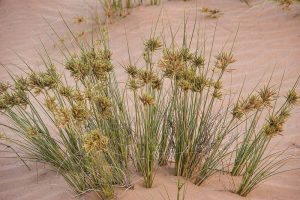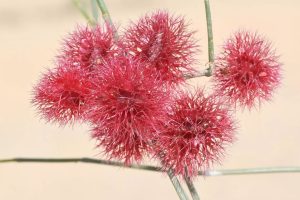Haloxylon salicornicum, commonly known as “Remth”, is a desert shrub native to the Arabian Peninsula, including Kuwait. Renowned for its extreme drought resistance, it is a cornerstone of desert ecosystems, playing a crucial role in combating desertification and supporting wildlife in arid environments.
🌱 Key Characteristics
- Appearance:
Remth is a woody, bushy shrub that typically grows up to 1 meter in height. It has slender, jointed stems with small, scale-like leaves, giving it a characteristic broom-like appearance. - Adaptations to Harsh Conditions:
- Deep root systems allow it to access groundwater and thrive in sandy, nutrient-poor soils.
- Its ability to withstand prolonged drought makes it a vital species in desert ecosystems.
- Blooming Period:
Haloxylon salicornicum produces small, inconspicuous flowers from March to May, which eventually give way to tiny seeds dispersed by the wind.
🌵 Ecological Importance
- Soil Stabilization:
Remth’s extensive root systems help anchor sandy soils, reducing erosion caused by wind and water. - Support for Grazing Livestock:
The plant serves as a critical source of fodder for camels, goats, and sheep, particularly during dry seasons. - Biodiversity Support:
It provides shelter and sustenance for insects, birds, and small desert animals, fostering a balanced ecosystem in harsh environments. - Carbon Sequestration:
As a perennial shrub, it contributes to reducing desertification and capturing atmospheric carbon, promoting climate resilience.
🌠Cultural and Traditional Uses
- Livestock Feed:
Remth has historically been a vital source of sustenance for livestock, especially camels, during periods of food scarcity. - Medicinal Benefits:
The plant is used in traditional medicine for its purported diuretic and digestive properties, as well as to treat minor wounds and skin conditions.
âš ï¸ Challenges and Threats
Despite its resilience, Haloxylon salicornicum faces several threats:
- Overgrazing: Excessive feeding by livestock depletes plant populations and prevents natural regeneration.
- Urban Development: Habitat loss due to construction and infrastructure projects.
- Climate Change: Increasing temperatures and changing rainfall patterns pose challenges to its growth and survival.
🌱 Conservation Tips for Haloxylon salicornicum
- Promote Responsible Grazing:
Encourage herders to adopt rotational grazing to allow Remth populations to recover and flourish. - Integrate Remth in Desert Restoration Projects:
Use Haloxylon salicornicum in reforestation and land rehabilitation programs to combat desertification. - Preserve Natural Habitats:
Establish conservation zones to protect wild populations from urban encroachment and overuse. - Community Education:
Educate local communities about the ecological and economic value of Remth and the importance of its conservation. - Seed Collection and Propagation:
Support initiatives to collect seeds and propagate Haloxylon salicornicum in nurseries for large-scale revegetation efforts.
At Nowair Kuwait Agriculture Services, we recognize the importance of protecting native plants like Haloxylon salicornicum to sustain Kuwait’s natural heritage and desert ecosystems. By adopting sustainable practices and promoting awareness, we can ensure the survival of this invaluable plant for generations to come. Let’s take action to preserve our desert landscapes. ðŸŒ




